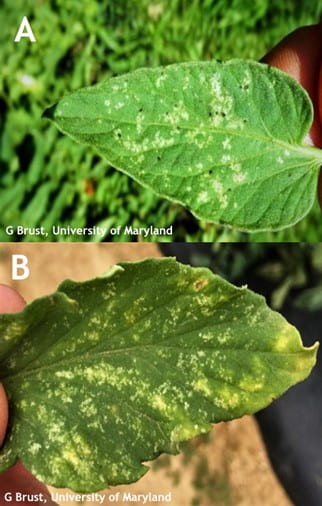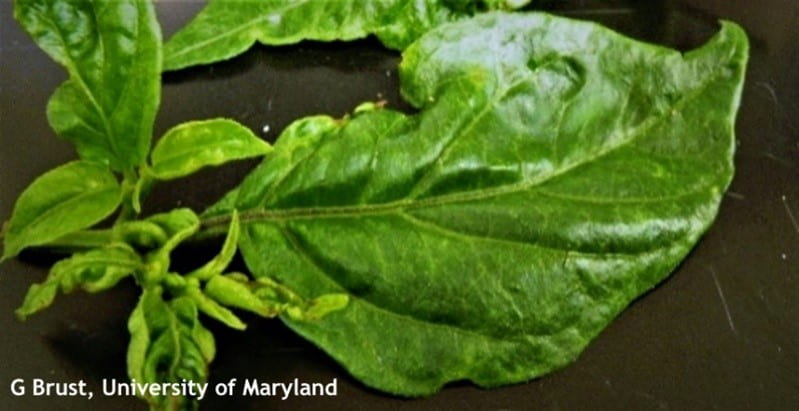The hotter temperatures we have had have caused thrips and to a lesser extent two spotted spider mite, TSSM (Tetranychus urticae) populations to rapidly increase in some vegetable fields in Maryland.
These pests feed by puncturing the outer layer of plant tissue and sucking out the cell contents, which results in stippling, discolored flecking, or silvering of the leaf surface (Fig.1).
We will talk mostly about thrips this time as I covered TSSMs in an earlier article. Thrips feeding is usually accompanied by black flecks of frass (thrips poop) (Fig. 1a), while mite poop is white or clear.


These two pests can discolor and scar leaf, flower, and fruit surfaces, and distort plant parts and, in the case of thrips, vector plant pathogens. There are several species of vegetable thrips with the most common being the Eastern flower thrips, Frankliniella tritici, Tobacco thrips Frankliniella fusca, Western flower thrips, F. occidentalis and Onion thrips Thrips tabaci. The last three species are the ones most likely to transmit tomato spotted wilt virus, TSWV.
Thrips feeding produces various tissue responses, including scar formation and distorted growth (fig. 2). Females of most plant-feeding species lay their kidney-shaped eggs on or into plant tissue (this latter placement makes it practically impossible to find thrips eggs on plants). Thrips hatch from an egg and develop into two larval stages and then the ‘prepupa and pupa’ stages, before becoming an adult. The prepupae and pupae of most species drop to the soil or leaf litter to pupate. Thrips have several generations (up to eight) a year. When the weather is warm, the life cycle may be as short as 2 weeks.
Thrips thresholds for vegetables are: flowers of tomato, pepper or watermelon can tolerate 5 thrips/flower with no fruit developmental problems. Squash and pumpkin flowers can tolerate 5-10 thrips/flower with no effect on fruit quality. One or two applications of a pyrethroid or neonic or spinosad (see 2020/2021 Mid-Atlantic Commercial Vegetable Production Recommendation guide) applied with enough water (60-80 gal/a, you have to have thorough coverage) should control most thrips infestations.
For two spotted spider mites Agri-Mek has shown very good results even when spray coverage was inadequate. There are several other miticides such as Acramite that also will give good control of TSSM and can be found in the recommendations guide. Be sure to apply any pesticides when bees will not be active in the field.
Some of the populations of thrips and mites in the field now are probably the result of transplants that were lightly infested with these pests. These infestations usually consist of immatures, which are hard to spot or eggs that are just about impossible to find if they laid inside leaf tissue (thrips) or there are only a few of them on the underside of the leaf in crevices (mites). Studies I have conducted show that if you treat your transplants (especially tomatoes) with 2 applications of a horticultural oil spray (0.5-1% by volume) with the first application coming 7-10 days before transplanting and the 2nd coming 1-2 days (or per label instructions) before you go to the field, you can almost eliminate any thrips or two spotted spider mite problems that started from your transplants.
During the season spraying more than 3-4 times for thrips or two spotted spider mites in the field over a 4-5-week period with little control will lead to an even worse problem. This is because the sprays will greatly reduce all of the pests’ natural enemies, but not the thrips or TSSM that may have developed resistance to the applied pesticides. Once you apply an insecticide or miticide you need to evaluate how well it worked by scouting the field again a few days after the application. If the pests are still very active you need to reevaluate what was applied and how it was applied.
Contact your county educator or crop specialist for help in making the evaluation.
– Jerry Brust, IPM Vegetable Specialist, University of Maryland
Figure 2 at top. Pepper leaf distortions due to thrips feeding.















